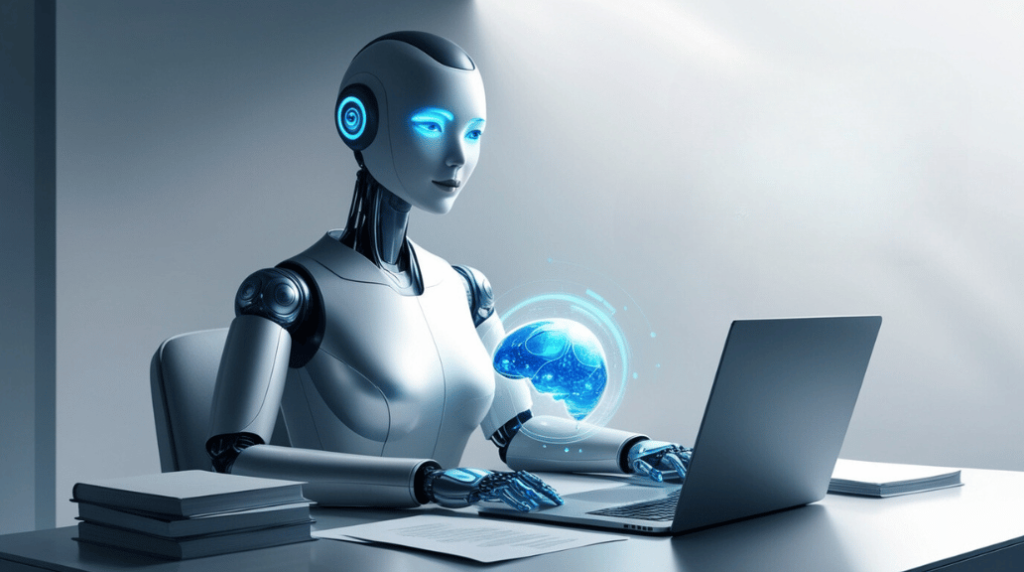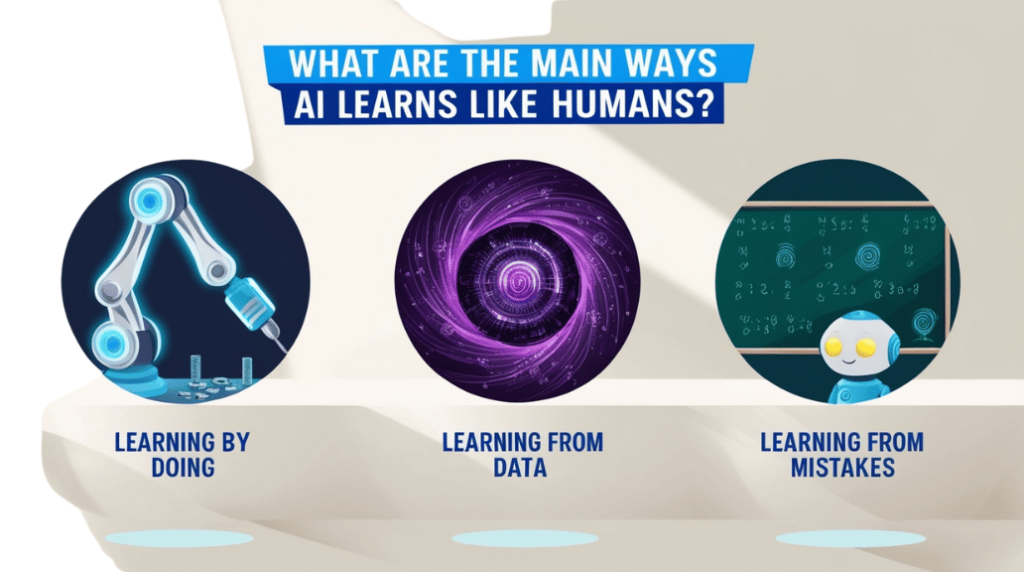In the world of technology, one of the most amazing advancements is the rise of Artificial Intelligence. AI is a powerful tool that helps solve problems, make decisions, and automate tasks. But have you ever wondered how AI learns? Even more interesting is that AI learns in ways similar to how you learn. This detailed post will dive deep into the different ways AI learns and explore how those ways are similar to your learning process as a human.
Why Is It Important to Understand How AI Learns Like Humans?

Understanding how AI learns is important because it helps you see how the technology around you works. Just like you learn new things by practicing and having experiences, AI learns in a similar way. It can make you feel more confident and comfortable using AI tools in your daily life, whether it’s for work, entertainment, or personal tasks. Also, when we understand how AI learns, we can create better and more intelligent AI systems that will work more efficiently and safely in different areas like healthcare, education, and customer service.
What Are the Main Ways AI Learns Like Humans?

Learning by Doing: Experience-Based Learning
Humans learn by practicing. The more you do something, the better you become at it. AI follows a similar process of learning by practicing.
- Humans: Imagine you’re learning to play a new video game. You might not win the first time, but as you keep playing, you start to understand the controls and how to win better.
- AI: AI uses a method called reinforcement learning. It tries different actions and gets feedback on whether they are good or bad. For example, in a game, AI tries different moves and learns from whether it wins or loses. Over time, it gets better at making the right decisions based on what it has learned before.
Example:
In self-driving cars, the AI learns to drive by constantly interacting with real-world data, like images, road signs, and traffic patterns. Every time it gets feedback, it makes changes to improve and become better at driving safely.
Learning from Data: Gathering Information
Another way humans and AI learn similarly is by collecting data.
- Humans: When you study for a test, you read books, watch videos, or listen to a teacher. The more information you gather, the better you understand the topic.
- AI: AI learns from large amounts of data. It collects information like images, text, or sound and then analyzes it to find patterns. For example, AI can learn to recognize animals in photos by studying thousands of pictures and noticing details like fur, shape, or size.
Example:
AI systems in online shopping learn what you like by analyzing what you browse and buy. It helps them suggest products you might be interested in based on what you’ve done before.
Learning from Mistakes: Trial and Error
Both humans and AI use trial and error to improve.
- Humans: For example, when learning to bake, you might add too much sugar the first time, but the next time, you use less to make it taste better. Each mistake helps you get better.
- AI: Similarly, AI systems learn from their mistakes. They try different actions, get feedback, and learn how to improve. For example, in reinforcement learning, AI may try something that doesn’t work but keeps learning until it finds the best way to reach its goal.
Example:
An AI program that teaches robots how to stack blocks might not work well at first because the robot might not hold the blocks properly or make mistakes. But by trying and learning from mistakes, the robot finds the best way to stack the blocks correctly.
How AI Learns Similar to How You Learn in Specific Fields
Let’s explore a few areas where AI learns the same way as humans.
AI and Human Learning in Healthcare
In healthcare, AI and humans learn from medical data to improve diagnosis and patient treatment.
- Humans: Doctors learn from medical books, past patient cases, and training. With time, they get better at understanding and treating patients through experience and study.
- AI: AI systems are trained to recognize diseases like cancer by analyzing medical images and patient data. The more data AI gets, the better it becomes at diagnosing diseases, just like how doctors improve by seeing more cases.
Example:
AI is already being used in radiology to spot signs of diseases, like tumors, by looking at X-rays and MRIs, just like doctors do.
AI and Human Learning in Education
Education is another area where AI and humans learn in similar ways. Both improve by learning from interactions and data to become better at their jobs.
- Humans: Students learn by attending classes, doing homework, and practicing what they’ve learned. Teachers check how students are doing and change their teaching to help each student better.
- AI: AI-powered tutoring systems like Duolingo or Khan Academy adjust to suit each student’s learning speed. As you use these tools, the AI adjusts the difficulty based on how well you’re doing, just like a teacher adjusts lessons based on your performance.
Example:
An AI learning platform might start with easier questions and slowly make them harder as you master new concepts, helping you learn at your speed.
How Neural Networks Help AI Learn Like the Human Brain
One key way AI learns like humans is through artificial neural networks (ANNs). These networks work like the brain by recognizing patterns and helping AI make decisions.
- Humans: Your brain has billions of neurons that work together. These neurons help you recognize faces, remember things, and make decisions.
- AI: In artificial neural networks, AI systems use layers of artificial neurons to process information. Each layer analyzes the data step by step, just like how your brain processes information in stages.
How AI Neural Networks Work in Layers
AI breaks down tasks into layers. The first layer looks at simple features (like edges in an image), the next layer recognizes more difficult patterns (like shapes), and the last layer combines everything to identify objects or scenes.
Example:
An AI used in facial recognition starts by detecting basic features like edges or shapes. Then, it looks for more difficult patterns, like eyes and noses, and finally, it recognizes the entire face.
Challenges AI Faces in Learning Like Humans
Even though AI learns in similar ways to humans, it still faces some challenges.
Lack of Creativity
Humans are naturally creative. You can develop new ideas, write stories, or create art. AI, on the other hand, lacks true creativity. It can only work within the limits of the data it’s given.
Example:
AI can generate music or art by learning from existing works, but it cannot create entirely new genres or styles like a human artist can.
Bias in Learning
Humans are influenced by their own biases, and AI can also have biases if it is trained on biased data. If AI learns from unfair or incomplete data, it can make unfair decisions.
Example:
If an AI system used for hiring is trained on data from a company with a biased hiring history, it might unfairly favor one group of applicants over others.
Emotional Understanding
Humans use emotions to make decisions, like choosing friends or deciding the best solution for a problem based on how it makes them feel. AI doesn’t have emotions, so it can’t understand or react to human feelings.
Example:
In customer service, a human representative can sympathize with a customer’s frustration, but an AI chatbot can only give robotic responses without truly understanding the emotions behind them.
Conclusion
At first, AI and human learning might seem very different. But when you look closer, you’ll see that AI learns in many of the same ways as humans. Both humans and AI learn from experience, data, mistakes, and feedback. Whether it’s through practice, gathering information, or trial and error, AI improves over time, just like you get better as you learn and grow.
As AI keeps improving, understanding these similarities will make you feel more comfortable using and working with it. Whether AI is helping doctors diagnose diseases, creating personalized education plans, or improving customer service, the way AI learns is leading to more brilliant and effective systems.
So, the next time you use AI, remember: it’s learning just like you are!


1 thought on “How Are the Ways AI Learns Similar to How You Learn?”